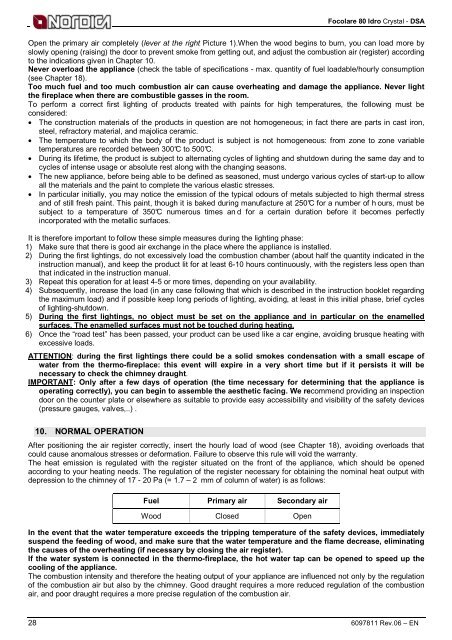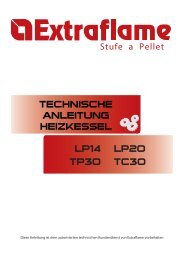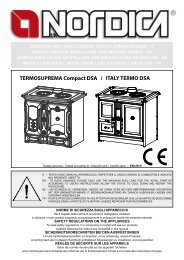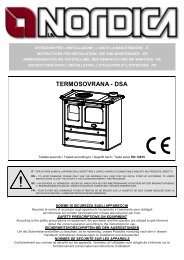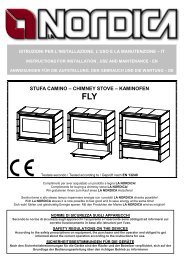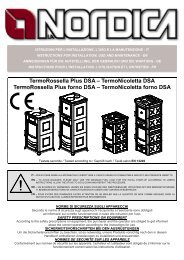FOCOLARE 80 Idro Crystal - DSA - HJS-Internethandel
FOCOLARE 80 Idro Crystal - DSA - HJS-Internethandel
FOCOLARE 80 Idro Crystal - DSA - HJS-Internethandel
You also want an ePaper? Increase the reach of your titles
YUMPU automatically turns print PDFs into web optimized ePapers that Google loves.
Focolare <strong>80</strong> <strong>Idro</strong> <strong>Crystal</strong> - <strong>DSA</strong><br />
Open the primary air completely (lever at the right Picture 1).When the wood begins to burn, you can load more by<br />
slowly opening (raising) the door to prevent smoke from getting out, and adjust the combustion air (register) according<br />
to the indications given in Chapter 10.<br />
Never overload the appliance (check the table of specifications - max. quantity of fuel loadable/hourly consumption<br />
(see Chapter 18).<br />
Too much fuel and too much combustion air can cause overheating and damage the appliance. Never light<br />
the fireplace when there are combustible gasses in the room.<br />
To perform a correct first lighting of products treated with paints for high temperatures, the following must be<br />
considered:<br />
• The construction materials of the products in question are not homogeneous; in fact there are parts in cast iron,<br />
steel, refractory material, and majolica ceramic.<br />
• The temperature to which the body of the product is subject is not homogeneous: from zone to zone variable<br />
temperatures are recorded between 300°C to 500°C.<br />
• During its lifetime, the product is subject to alternating cycles of lighting and shutdown during the same day and to<br />
cycles of intense usage or absolute rest along with the changing seasons.<br />
• The new appliance, before being able to be defined as seasoned, must undergo various cycles of start-up to allow<br />
all the materials and the paint to complete the various elastic stresses.<br />
• In particular initially, you may notice the emission of the typical odours of metals subjected to high thermal stress<br />
and of still fresh paint. This paint, though it is baked during manufacture at 250°C for a number of h ours, must be<br />
subject to a temperature of 350°C numerous times an d for a certain duration before it becomes perfectly<br />
incorporated with the metallic surfaces.<br />
It is therefore important to follow these simple measures during the lighting phase:<br />
1) Make sure that there is good air exchange in the place where the appliance is installed.<br />
2) During the first lightings, do not excessively load the combustion chamber (about half the quantity indicated in the<br />
instruction manual), and keep the product lit for at least 6-10 hours continuously, with the registers less open than<br />
that indicated in the instruction manual.<br />
3) Repeat this operation for at least 4-5 or more times, depending on your availability.<br />
4) Subsequently, increase the load (in any case following that which is described in the instruction booklet regarding<br />
the maximum load) and if possible keep long periods of lighting, avoiding, at least in this initial phase, brief cycles<br />
of lighting-shutdown.<br />
5) During the first lightings, no object must be set on the appliance and in particular on the enamelled<br />
surfaces. The enamelled surfaces must not be touched during heating.<br />
6) Once the “road test” has been passed, your product can be used like a car engine, avoiding brusque heating with<br />
excessive loads.<br />
ATTENTION: during the first lightings there could be a solid smokes condensation with a small escape of<br />
water from the thermo-fireplace: this event will expire in a very short time but if it persists it will be<br />
necessary to check the chimney draught.<br />
IMPORTANT: Only after a few days of operation (the time necessary for determining that the appliance is<br />
operating correctly), you can begin to assemble the aesthetic facing. We recommend providing an inspection<br />
door on the counter plate or elsewhere as suitable to provide easy accessibility and visibility of the safety devices<br />
(pressure gauges, valves,..) .<br />
10. NORMAL OPERATION<br />
After positioning the air register correctly, insert the hourly load of wood (see Chapter 18), avoiding overloads that<br />
could cause anomalous stresses or deformation. Failure to observe this rule will void the warranty.<br />
The heat emission is regulated with the register situated on the front of the appliance, which should be opened<br />
according to your heating needs. The regulation of the register necessary for obtaining the nominal heat output with<br />
depression to the chimney of 17 - 20 Pa (= 1.7 – 2 mm of column of water) is as follows:<br />
Fuel Primary air Secondary air<br />
Wood Closed Open<br />
In the event that the water temperature exceeds the tripping temperature of the safety devices, immediately<br />
suspend the feeding of wood, and make sure that the water temperature and the flame decrease, eliminating<br />
the causes of the overheating (if necessary by closing the air register).<br />
If the water system is connected in the thermo-fireplace, the hot water tap can be opened to speed up the<br />
cooling of the appliance.<br />
The combustion intensity and therefore the heating output of your appliance are influenced not only by the regulation<br />
of the combustion air but also by the chimney. Good draught requires a more reduced regulation of the combustion<br />
air, and poor draught requires a more precise regulation of the combustion air.<br />
28 6097811 Rev.06 – EN


